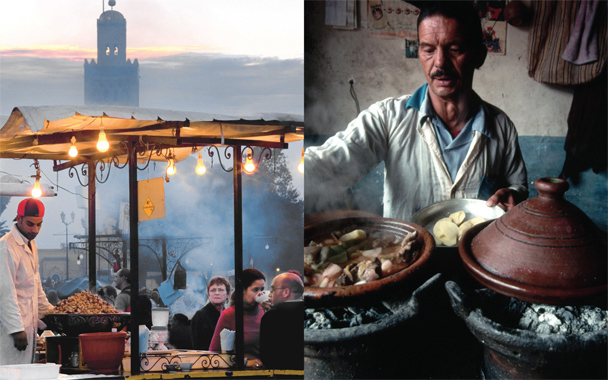All of the houses in the Medina [Old Town] are being bought by foreigners. We can’t afford to live here anymore,” said the smiling guide who led me through a series of narrow lanes to the stunning new luxury riad Noir d’Ivoire, the lavish creation of Jill Fechtmann and Jean Michel Jobit, an Anglo-French couple who previously lived in France and Swaziland. In Marrakech ten years ago, there were only a few dozen riads—traditional Moroccan houses built around interior courtyards. Now an estimated two thousand of these Arabian Nights–style lodgings exist in the city, catering to the seemingly limitless appetite of affluent Europeans (and a small but growing number of Americans) for Moroccan sunshine and exoticism.
“Marrakech is reaching a tipping point,” says Cyrus, manager of Riad Meriem, another recently opened Medina hotel. “The danger is that the new cheap flights from Europe will start attracting swimming-pool and beer tourists, or the kiss-me-quick crowd who go to Benidorm and Torremolinos in Spain. The city won’t be able to absorb all of these tourists without disrupting its traditional way of life.”
The city’s hotel-building boom continues unabated, with new near-term projects in the pipeline from the Four Seasons, Mandarin Oriental, Rocco Forte Hotels, and the French group Lucien Barrière, which is planning not only a hotel but a Marrakech branch of Fouquet’s, the famous restaurant on the Champs Elysées. “Marrakech is becoming the Saint Tropez of the Maghreb [northern Africa],” says Jill Fechtmann. A major expansion of the city’s airport is nearing completion to accommodate the explosive growth of low-cost flights from almost every major European city, and rumor has it that Delta will soon begin direct service from New York.
The local tourist boom is also having a major impact on Marrakechi eating habits. The huge demand for seafood by Morocco’s thriving tourist industry, coupled with the fact that industrialized Asian and European fishing fleets are emptying the once fertile fishing grounds off of Morocco’s long Atlantic Coast, means that fish has become rarer and costly. Fruit and vegetables are becoming more expensive, too, as precious agricultural land is bought up for villa colonies and golf courses, and the traditional kettara, or irrigation pipes, in the Palmeraie are no longer maintained. Sunbelt-style apartment complexes springing up on the edge of the city are flanked by new American-style shopping malls with Marjane supermarkets (formerly the Moroccan branch of the French Auchan supermarket chain).
The tourist-driven local restaurant boom has also produced an odd hybrid Moroccan resort cuisine that combines the staple dishes of global tourism like salads, tapas, pasta, and pizza with inspiration from the Moroccan kitchen and southeast Asia. “Most tourists tire of tagines and couscous after two or three days, so we’ve had no choice but to invent a cooking style that appeals to them,” explains the owner of another new Belgian-owned riad hotel. Angsana, the sister brand of the Singapore-based Banyan Tree hotel group, is marketing the fact that it has taught the Moroccan chefs in its seven riad hotels how to cook Thai food (they also cook Moroccan food), and has introduced dishes like the Koutbia Burger, merguez (lamb) sausages on a roll with sautéed peppers and a side of fries.
If the substantial French expat community still likes a taste of Gaul at places like the Grand Café de la Poste and Chez Pascal, trendy tables like Le Foundouk, Riad Tamsna, and Le Comptoir offer good (if rather deracinated) world-food menus. Insisting on confidentiality, another hotel manager observes that some of the female cooks who do the city’s best food are increasingly reluctant to work in tourist settings because they’re being discouraged by the fundamentalist imams in some local mosques.
“Competition for good Moroccan chefs is ferocious,” says Jill Fechtmann. “Chef poaching is a major local problem—there are simply not enough of them to go around.”
Meanwhile, reservations have become essential at all Marrakech restaurants, especially places like Al Fassia, a clubby place that pulls a stylish mixture of expats, politicians, and local power brokers, and that is locally considered to be the best non-touristy Moroccan table.
Happily, however, there are still ways to escape the madding crowds in Marrakech and also eat superb local cooking. Weather permitting, book a rooftop dinner for two at Angsana Riad Si Said (011-212-24-421-979), where exceptionally talented young chef Malika Rhali cooks some of the best tagines in town, including what just might be the best dish in Marrakech right now—a sublime tagine sucré, which is made with lamb, honey, almonds, raisins, garlic, and saffron.
Al Fassia 55 Boulevard Zerktouni (011-212-24-434-060)
Riad Noir d’Ivoire 31 Derb Jdid Bab Doukkala (011-212-24-380-975; noir-d-ivoire.com)
Angsana Riad Si Said 1-2-4 Derb Abbes El Fassi (011-212-24-421-979; angsana.com)
Grand Café de la Poste 127 Ave. Mohamed V (011-212-24-433-038; grandcafedelaposte.com)
Chez Pascal 96 rue Mohamed El Baqal (011-212-24-447-415)
Le Comptoir Ave. Echouhada - Hivernage (011-212-24-437-702; comptoirdarna.com)
Le Foundouk 55 Souk El Fassi (011-212-24-378-190; foundouk.com)


